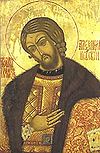- Afanasy Ordin-Nashchokin
-
Afanasy Lavrentievich Ordin-Naschokin (Russian: Афанасий Лаврентьевич Ордин-Нащокин) (1605–1680) was one of the greatest Russian statesmen of the 17th century. His career is quite unprecedented in Russian history, as he was the first petty noble to attain the boyar title and highest offices of state owing not to family connections but due to his personal ability and worth. In many things he anticipated Peter the Great. He was absolutely incorruptible, thus standing, morally as well as intellectually, far above the level of his age.
Early life and career
He was the son of a poor official at Pskov, who saw to it that his son was taught Latin, German and mathematics. Ordin began his public career in 1642 as one of the delineators of the new Russo-Swedish frontier after the peace of Stolbovo. Even then he had a great reputation in Russia as one who thoroughly understood "German ways and things". He was one of the first Russians who diligently collected foreign books, and we hear of as many as sixty-nine Latin works being sent to him at one time from abroad.
He attracted the attention of the young Tsar Alexis by his resourcefulness during the Pskov rebellion of 1650, which he succeeded in localizing by personal influence. At the beginning of the Russo-Swedish War (1656-1658), Ordin was appointed to a high command, in which he displayed striking ability.
Diplomatic missions
In 1657 he was appointed minister plenipotentiary to treat with the Swedes on the Narva River. He was the only Russian statesman of the day with sufficient foresight to grasp the fact that the Baltic seaboard, or even a part of it, was worth more to Russia than ten times the same amount of territory in Lithuania, and, despite ignorant jealousy of his colleagues, succeeded (Dec. 1658) in concluding a three-year Treaty of Valiesari whereby the Russians were left in possession of all their conquests in Livonia.
In 1660 he was sent as plenipotentiary to a second congress, to convert the truce of 1658 into a permanent peace. He advised that the truce with Sweden should be prolonged and Charles II of England invited to mediate a northern peace. Finally he laid stress upon the inimense importance of Livonia for the development of Russian trade. On being overruled he retired from the negotiations which led to the Treaty of Kardis.
He was the chief plenipotentiary at the abortive congress of Durovicha, which met in 1664, to terminate the Russo-Polish War (1654-1667); he negotiated the Truce of Niemieża and it was due in no small measure to his superior ability and great tenacity of purpose that Russia succeeded in concluding with Poland the advantageous Truce of Andrusovo (1667). On his return to Russia he was created a boyar of the first class and entrusted with the direction of the Foreign Office, with the title of Guardian of the great Tsarish Seal and Director of the great Imperial Offices. He was, in fact, the first Russian chancellor.
Later life and achievements
It was Ordin who first abolished the onerous system of tolls on exports and imports, and established a combination of native merchants for promoting direct commercial relations between Sweden and Russia. He also set on foot a postal system between Russia, Courland and Poland, and introduced gazettes and bills of exchange into Russia. With his name, too, is associated the building of the first Russian merchant-vessels on the Dvina and Volga.
But his whole official career was a constant struggle with narrow routine, and personal jealousy on the part of the boyars and clerks of the council. He was last employed in the negotiations for confirming the truce of Andrusovo (September 1669; March 1670). In January 1671 we hear of him as in attendance upon the tsar on the occasion of his second marriage; but in February the same year he was dismissed, and withdrew to the Krypetsky monastery near his native Pskov. There he took the tonsure under the name of Antony, and occupied himself with good works till his death in 1680.
 This article incorporates text from a publication now in the public domain: Chisholm, Hugh, ed (1911). Encyclopædia Britannica (11th ed.). Cambridge University Press.
This article incorporates text from a publication now in the public domain: Chisholm, Hugh, ed (1911). Encyclopædia Britannica (11th ed.). Cambridge University Press.People from Russia Leaders and religious - Pre-1168
- 1168–1917
- 1922–1991
- 1991–present
- RSFSR leaders
- General secretaries
- Soviet premiers (1st deputies)
- Soviet heads of state (and their spouses)
- Prime ministers (1st deputies)
- Foreign ministers
- Prosecutors general
- Metropolitans and patriarchs
- Saints

Military and explorers - Field marshals
- Soviet marshals
- Admirals
- Aviators
- Cosmonauts
Scientists and inventors - Aerospace engineers
- Astronomers and astrophysicists
- Biologists
- Chemists
- Earth scientists
- Electrical engineers
- IT developers
- Linguists and philologists
- Mathematicians
- Naval engineers
- Physicians and psychologists
- Physicists
- Weaponry makers
Artists and writers Sportspeople - Chess players
Categories:- Foreign Ministers of Russia
- Russian diplomats
- 1605 births
- 1680 deaths
Wikimedia Foundation. 2010.

